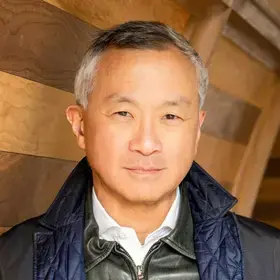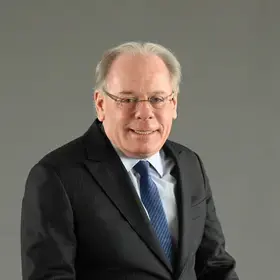If there is a unifying aspect to Sreenath “Sree” Sreenivasan's career, it is strategic storytelling. A longtime journalist, social media educator, and community-builder, Sreenivasan—as The Metropolitan Museum of Art's first Chief Digital Officer—is also one of the nonprofit sector's first all-star new media executives, making Fast Company’s Most Creative People list last year for his efforts to “liberate the museum from its physical walls” using social media platforms that “get people to experience the museum in new ways.”
Sreenivasan, formerly a professor of digital journalism in Columbia University’s Graduate School of Journalism and Dean of Student Affairs, recently delivered a Master Class lecture for the Nonprofit Management master’s program at Columbia’s School of Professional Studies as a guest of instructors Marcia Stepanek, Howard Greenstein, and Tom Watson. Stepanek, Greenstein, and Watson co-teach The Wired Nonprofit for the program.
Following Sreenivasan's lecture—which live-trended globally on Periscope—Stepanek sat down with “Sree” to talk about his 2013 transition from educator and social media strategist to nonprofit executive. An edited and condensed version of his remarks appear here.
We have seen many rapid and disruptive changes in the nonprofit sector during recent years, many driven by digital media. In your view, what are some of the biggest strategic challenges facing leaders of nonprofits as a result of those changes?
Sreenivasan: Things are changing so fast that it can be overwhelming. We are going to see more change in the next five years than the last 15 but at a faster pace. It's hard to get people to focus. Even as I'm talking to you, I have my phone in my lap. If I put it away, it's going to start beeping and buzzing.
How does this affect the way that nonprofit leaders have to look at how they manage people, and how they manage change inside the organization?
We all have to learn together. In the nonprofit world, we can learn so much from everyone else, and I learn every day from museums that are very small and museums that are very big. I learn from nonprofits that are very small and that are very big. Most of them are using the same kinds of tools that are available to most people at a very small budget. You can do a lot. You can't do everything at a very small budget, but you can at least think about it.
As a leader, it’s about understanding the pace of change and understanding that it’s going to happen no matter what. You have to embrace it if you want to be successful. The Met opened its first website in 1995, three years before Google. The worry was that if we put content online, people wouldn’t come to the museum. We know that that’s not the case. The more we put online, the more people want to go to things.
In every industry, there’s some parallel; there’s something that you cannot do because it has never been done before. So what are the things that you can experiment on? My message is: are there things you can do that are simple and easy? Can you bring along your folks by not trying to overdo it immediately? If you focus on just outcome and not focus on that journey, I think you're not going to be as successful in the digital space.
As nonprofit leaders start to experiment with new ways to collect data using digital media and then to analyze it to achieve better engagement with current and potential supporters, what opportunities are you seeing for The Metropolitan Museum and for the nonprofit sector at large?
At The Met, we have been always very good at counting people in the door and evaluating our programs, but we weren’t very good at counting our digital audience or thinking about that. We found an expert in digital analytics in the arts sector specifically, and her arrival has changed what we do because we base it on what is best for the user. You have to become a student of your own data even if you do nothing with it. What’s happening, what are the trends, what are the underlying trends, and what’s changing? If you determine that, you’ll have the opportunity for success.
Power is moving outside the organization with these tools in our hands. How is this affecting our ability to take part in causes and what new responsibilities does it demand of our leaders at nonprofits? How transparent do we need to be?
It’s very important to be transparent because that’s what people expect. The premise of the work we do is that you have to tell stories. The reason I was hired is because I know how to tell stories. If we’re going to tell stories, we have to tell every part of the story, not just the kind of well-packaged thing that you can control. At The Met, our boss Tom Campbell, who is the CEO and Director of the museum, has had an Instagram account for a year and a half or so and he’s fantastic on it. He’s exhibiting a new kind of leadership, leadership that comes from three things: generosity, transparency, and a feeling of confidence. He’s posting something, he’s talking about the prep that goes into an exhibition, he’ll go to an exhibition, take photos, and share them before everybody else does. He is also posting about other museums. Tom, everywhere he travels, every museum he goes to, you will find he’s posting Instagrams from there. People are watching.
What are some of the takeaways that you can share about the change management part of your job?
It’s really about strategy. Once you have strategic vision then everything you do can be measured against that. It’s also important to remember that our work is in service of the art, our visitors, and our scholarly work. If the people at the very top are vested in it and lead by example, then it makes an impact. You can talk about any number of issues where you’re looking at gender diversity or ethnic diversity, or you want to change something about your company. The leader has to exhibit that first.
Can we do that in our own areas? Whatever the change might be, it may not be diversity; it may be something else. But we have to make that effort and that’s the only way that we have any impact in what we’re trying to do.
What are some of the other challenges that you see getting to the on-ramp?
Barriers are the technology. For a place like us, that includes recruiting, retaining, and promoting technology talent when we’re competing with Wall Street and server farms. How do we do that? You make it interesting to work there.
One of the things I’ve been struck by is that young people want to have an impact and want to make a difference, and that it’s our organizations, the nonprofit world, that attract them. Of course money is important but having an impact is as important, if not more. There are things that we can do to get do to get volunteers, get others, and harness that energy that we have around what we do.
Empower the junior staff in your team. That’s a big message of mine. They’re going to have a real passion for what they’re doing. Promote from within whenever you can but strategically bring in people from outside, whether it’s consultants or job opportunities.
I call myself the Chief Listening Officer of The Met—someone has to be listening for what’s new, what’s working, and what’s not working. But again, remember you don’t have to change everything immediately. I tell people I run a startup inside a 140-year-old company. We’re changing, but it will be slow—but in the context of 5,000 years of history, this is nothing.
This Q&A has been edited and condensed.
Learn more about the Master of Science in Nonprofit Management program and follow @Columbia_SPS for updates on the program’s Master Class guest lecture series with key leaders in social innovation.


